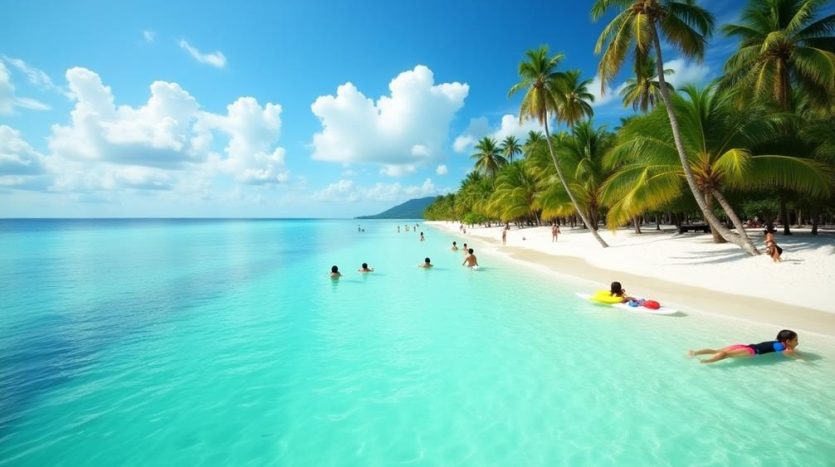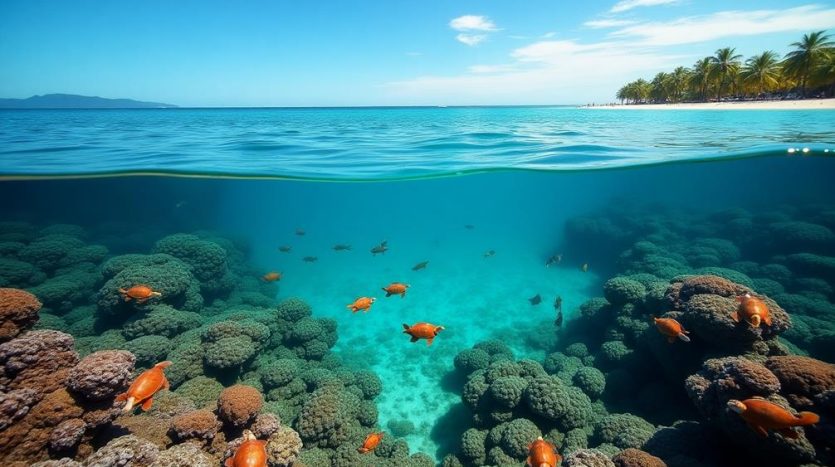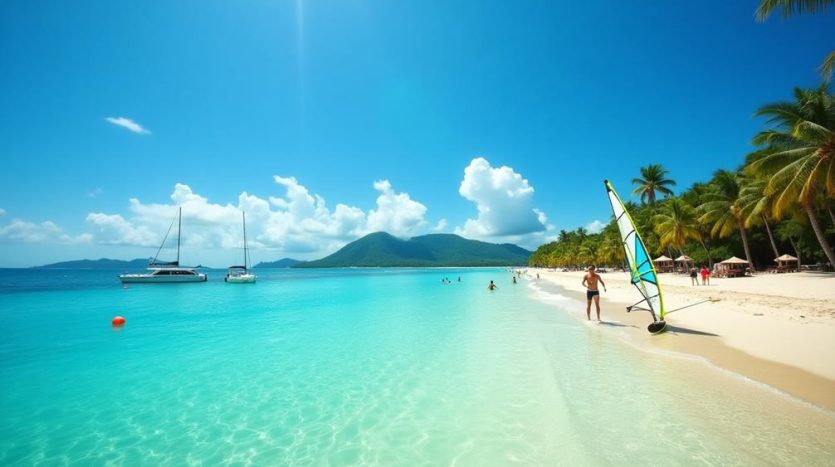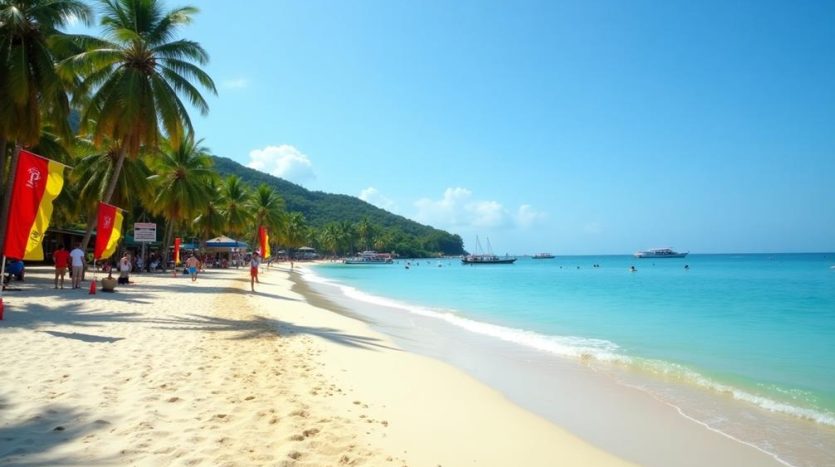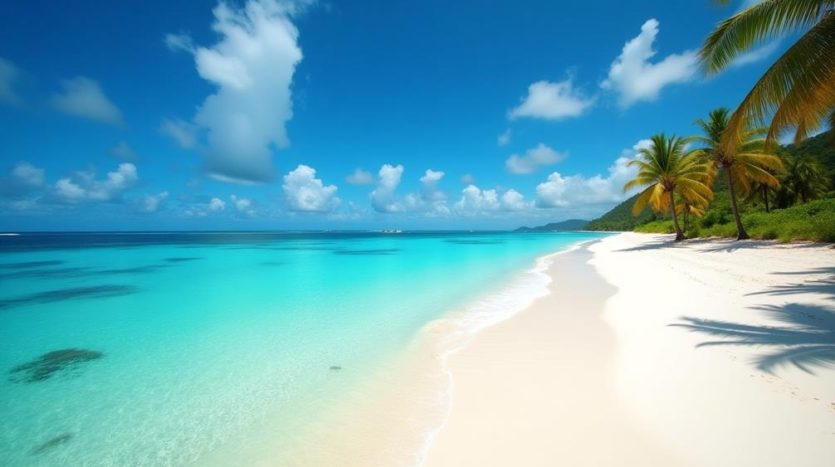Can You Swim in the Ocean in Koh Samui?
When you think about swimming in Koh Samui, you should consider more than just the clear waters and sandy beaches. The ocean's conditions can change quickly, going from calm to turbulent with strong currents. It's essential to pay attention to tide patterns, as high tide can bring the water closer to shore, while low tide may reveal less appealing mudflats. To swim safely, you'll need to heed lifeguard flags and local advice. But what about the best times of year to visit, or the most family-friendly spots? Let's explore these aspects further.
Key Takeaways
- Yes, you can swim in the ocean in Koh Samui, but always check current water conditions and weather forecasts.
- Observe beach flags and signs; red flags indicate dangerous swimming conditions.
- Best swimming months are January to April, with calm and inviting waters.
- Be cautious of marine life like jellyfish and respect coral preservation guidelines.
- Lifeguards and posted tide schedules at popular beaches enhance safety for swimmers.
Swimming Conditions
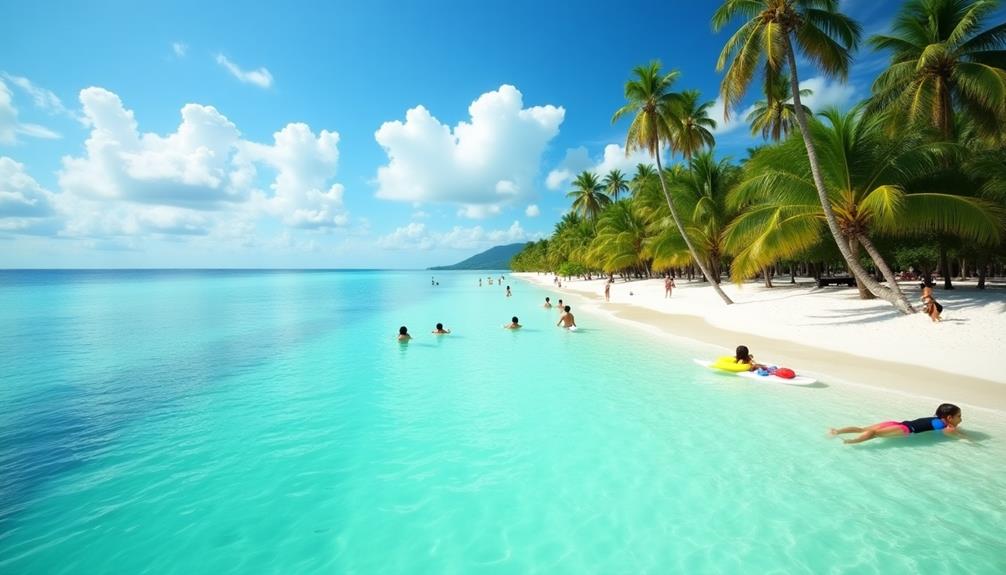
Thinking about a swim in the ocean around Koh Samui? You're in for a treat but first, let's chat about swimming conditions. Visualize this: crystal-clear waters gently lapping at powdery white sands. Sounds like paradise, right? But wait, there's more to reflect on.
Before you plunge in headfirst, you'll need a bit of currents awareness. The waters around Koh Samui can be as unpredictable as a cat on catnip. Some days, the currents are as calm as a yoga retreat; other days, they're like a rollercoaster ride. Keeping an eye on the currents not only keeps your swim enjoyable but also guarantees you don't end up in a surprise marathon to the next island.
It's good to know that safety measures are in place, helping assure a safe swimming experience.
Now, let's talk tide patterns. Koh Samui's tides have mood swings that rival a teenager's. High tide can bring the water almost up to your beach towel, while low tide can turn the ocean into a sprawling mudflat.
Knowing the tide patterns can save you from the embarrassment of getting stuck in knee-deep water or, worse, losing your flip-flops to the sea.
Safety Tips
When swimming in Koh Samui, you've got to stay aware of the water conditions to guarantee a safe experience.
Keep an eye out for marine life and respect their space to avoid any unpleasant encounters.
Also, always check the weather forecast, as sudden changes can impact the ocean's safety.
Water Condition Awareness
Before you plunge into the inviting waters of Koh Samui, it's essential to be aware of the ocean's ever-changing conditions for your safety. Tide patterns can be as unpredictable as a cat on catnip. One minute, you're frolicking in shallow, calm waters, and the next, you're wondering how the water got so deep so fast.
Keep an eye on the tide schedules, which are often posted at popular beaches. They're your best friend when it comes to avoiding sudden water level changes.
Don't forget about those sneaky coral reefs either. While they're beautiful and Instagram-worthy, they can pose a hazard if you're not careful. Coral reefs are like nature's own obstacle course—fun to look at but painful to crash into.
Wear water shoes to protect your feet and always be mindful of where you step or swim.
Furthermore, pay attention to flags and signs posted by lifeguards. A red flag isn't just a suggestion; it's a screaming "No swimming!" warning due to rough currents or other hazards.
Trust the locals—they know their beach better than anyone. Stay informed, stay aware, and you'll have a splash-tastic time!
Marine Life Precautions
Diving into the turquoise waters of Koh Samui is a dream come true, but don't let the allure distract you from the marine life precautions you need to take.
First off, let's talk about coral preservation. Those vibrant, colorful corals you see aren't just there for Instagram likes—they're living organisms. So, avoid stepping on them or breaking off pieces as souvenirs. Trust me, nobody wants to be the villain in Finding Nemo.
Now, onto jellyfish safety. These translucent jelly-bellies can give you a sting that feels like a thousand tiny hot pokers. Ouch! Keep an eye out for any warning signs on the beach, and if you see a jellyfish, back away slowly like it's an awkward ex at a party.
If you do get stung, rinse the area with vinegar or saltwater—pee is so last decade.
Lastly, remember to swim in designated areas. These zones are usually monitored for marine life activity, reducing your chances of an unwanted encounter.
Weather Impact Considerations
While you're keeping an eye out for jellyfish and respecting the corals, don't forget that the weather can greatly impact your ocean swimming experience in Koh Samui. The island's tropical climate means that conditions can change rapidly, and it's vital to stay informed to guarantee a safe and enjoyable swim.
First off, those ocean currents can be as unpredictable as your favorite sitcom's plot twists. Always check local weather reports and heed any warnings about strong currents. Tide patterns also play a significant role. High tides might bring you closer to those vibrant corals, but low tides could turn your swim into a wade-fest.
Here are some tips to keep you safe:
- Stay Updated: Always check the weather forecast before heading out.
- Observe Flags: Pay attention to beach safety flags – they're not just for decoration!
- Buddy System: Swim with a buddy; it's safer and way more fun.
- Emergency Numbers: Know local emergency contacts, just in case Poseidon decides to throw a tantrum.
Best Beaches
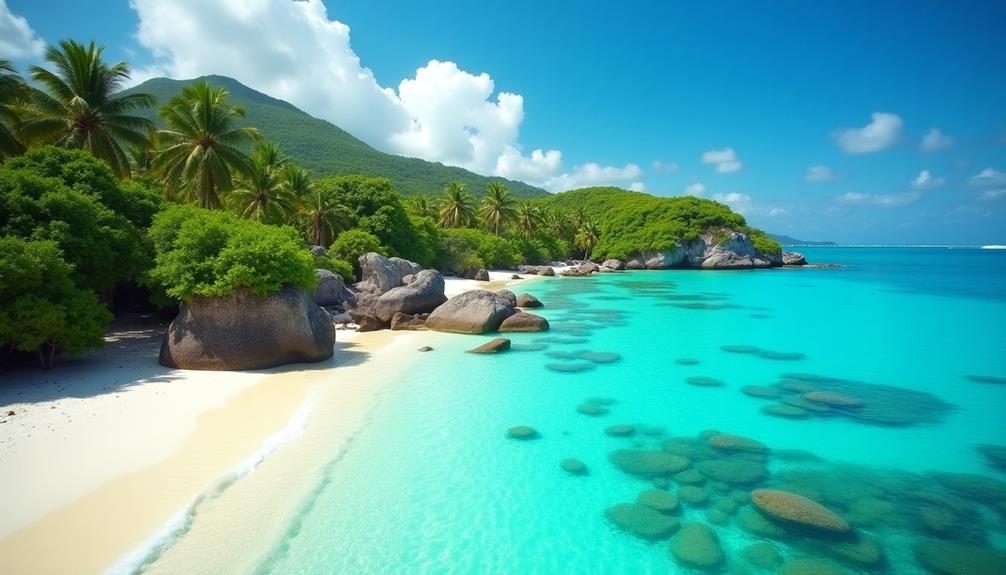
Koh Samui boasts some of the most stunning beaches in Thailand, making it a must-visit destination for any beach lover. Whether you're looking to relax under the sun, engage in coastal activities, or simply enjoy the beach amenities, Koh Samui has it all. Here's a quick guide to the best beaches you can't miss.
| Beach | Beach Amenities | Coastal Activities |
|---|---|---|
| Chaweng | Sun lounges, bars | Jet skiing, snorkeling |
| Lamai | Restaurants, massage huts | Kayaking, beach volleyball |
| Bophut | Cafés, boutique shops | Paddleboarding, fishing |
| Maenam | Hammocks, quiet spots | Swimming, sailing |
Chaweng Beach is the island's superstar, offering an array of beach amenities like sun lounges and beach bars. If you're an adrenaline junkie, you'll love jet skiing and snorkeling here. Lamai Beach is perfect if you want a bit of everything—delicious food, relaxing massages, and activities like kayaking and beach volleyball.
For a more laid-back vibe, head to Bophut Beach. Here, you can sip coffee at chic cafés or indulge in paddleboarding and fishing. Finally, Maenam Beach offers peace and tranquility with its hammocks and sailing opportunities, making it ideal for those who prefer a quieter escape.
Water Temperature
When planning a swim in the ocean around Koh Samui, it's essential to take into account the water temperature, which can greatly enhance your experience. The island's tropical climate means that water temperatures are usually inviting, but it's wise to be aware of variations that can occur due to ocean currents.
You'll generally find the water temperature ranges from a warm 27°C to 30°C (80°F to 86°F). This makes it perfect for a rejuvenating dip without the "polar bear plunge" vibe.
However, here are a few things to take into account:
- Seasonal Changes: During the hottest months from March to June, the water can feel like a soothing bath, while the cooler months might offer a brisker swim.
- Time of Day: Morning swims can be slightly cooler, but by midday, the water heats up nicely.
- Ocean Currents: Stronger currents can bring cooler water from deeper parts of the ocean, so be prepared for a slight chill now and then.
- Shallow vs. Deep: Shallow waters tend to warm up faster, while deeper areas can be cooler and more invigorating.
Marine Life
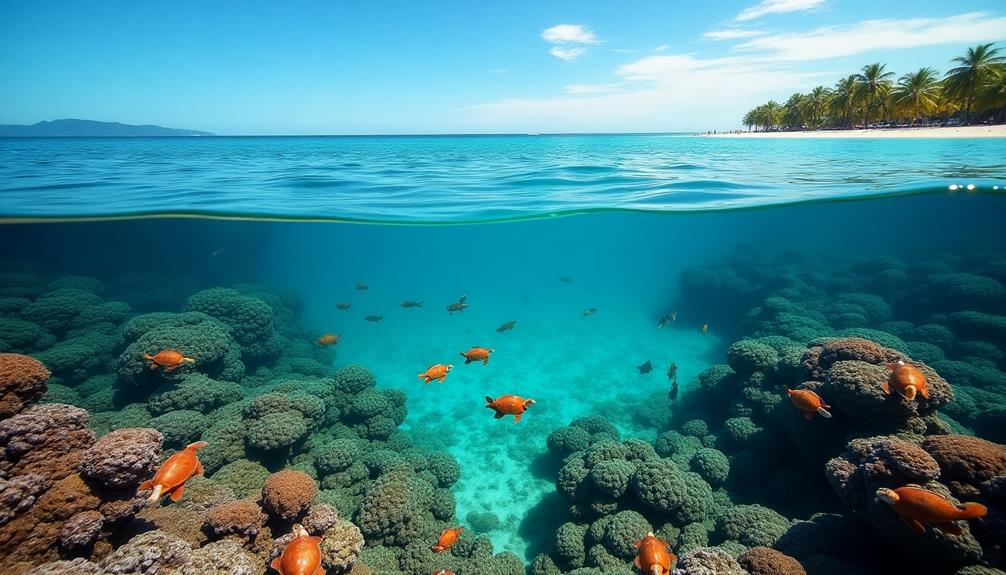
Exploring the marine life around Koh Samui offers an enchanting experience that you won't soon forget. Envision diving into crystal-clear waters, only to find yourself amidst vibrant coral reefs that look like something straight out of Finding Nemo.
These underwater gardens are teeming with a dazzling array of marine creatures, each one more colorful and quirky than the last.
Now, let's talk fish diversity. If you've ever wondered what it's like to swim in an aquarium, Koh Samui is the place to find out. Picture this: you're surrounded by schools of playful parrotfish, their neon colors flashing like underwater disco lights.
And just when you think it can't get any better, a majestic angelfish glides by, looking like it stepped right off a coral reef fashion runway.
But wait, there's more! Ever seen a clownfish in its natural habitat? Well, here's your chance. These adorable little guys love to hide in the nooks and crannies of the coral, playing peekaboo with lucky snorkelers like you.
Trust me, exploring the marine life here is like getting a backstage pass to nature's most exclusive show.
Seasonal Considerations
When planning your swim in Koh Samui, you've got to think about the seasons.
The monsoon season, from October to December, brings rough seas that can be risky.
For the best experience, aim to visit between January and April when the waters are calm and inviting.
Monsoon Season Risks
Venturing into the ocean around Koh Samui during the monsoon season demands extra caution due to the unpredictable and often treacherous sea conditions.
The monsoon impacts can transform your serene beach day into a scene from a disaster movie. Swift currents, towering waves, and limited visibility are just a few of the swimming hazards you'll face. Imagine wrestling with an ocean that's suddenly decided it's auditioning for the next big blockbuster.
When traversing these waters, keep an eye out for:
- Strong Currents: They're like nature's treadmill, but without the benefits. Once you're caught, it's a struggle to get back to shore.
- High Waves: These aren't the fun surfing kind. We're talking about waves that can knock you off your feet and toss you around like a rag doll.
- Debris: Monsoon rains can wash all sorts of debris into the ocean, turning your swim into an obstacle course.
- Poor Visibility: The churning waters make it hard to see what's beneath you, which can be both unnerving and dangerous.
Optimal Swimming Months
The best time to enjoy swimming in Koh Samui's ocean is during the dry season, which stretches from December to April. Imagine basking under the tropical sun, the waves gently lapping at your feet, and not a rain cloud in sight.
During these months, you'll find the ideal conditions for swimming, with calm seas and clear skies. No need to worry about dodging raindrops or battling strong currents—just pure, unadulterated beach bliss.
Seasonal variations play a huge role in your oceanic escapades. From May to November, the monsoon season can turn the waters into a choppy mess, making swimming a risky endeavor.
But come December, Koh Samui transforms into a swimmer's paradise. The sea is like a warm, inviting blanket, perfect for leisurely dips or more vigorous swims.
And let's not forget the water temperature, which hovers around a delightful 27-30°C (80-86°F).
Water Sports
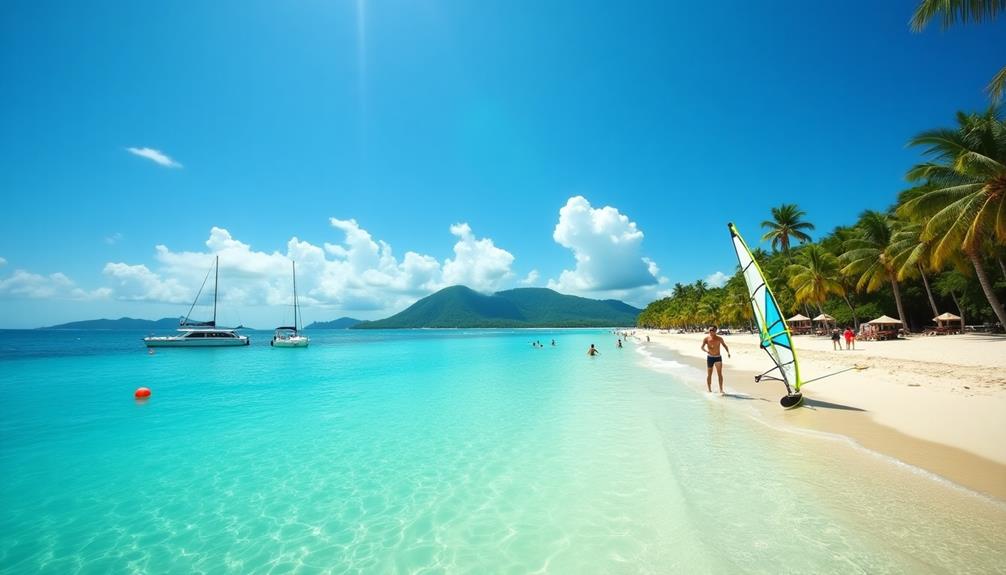
Dipping your toes into the azure waters of Koh Samui, you'll quickly discover that this tropical paradise is a haven for water sports enthusiasts.
From adrenaline-pumping activities to more laid-back aquatic fun, Koh Samui's got something for everyone.
Imagine catching a wave with the island's prime surfing opportunities. While it's no Hawaii, you can still find some decent swells, especially during the monsoon season.
If you're more of an underwater explorer, grab your snorkel gear. Snorkeling adventures here are exceptional, with crystal-clear waters revealing a vibrant marine world that's nothing short of an underwater disco.
Here's a taste of the water sports that await you:
- Jet Skiing: Feel like James Bond as you zip around the coastline.
- Paddleboarding: Perfect for showing off your balance—or lack thereof.
- Kayaking: Navigate the serene waters and discover hidden coves.
- Parasailing: Get a bird's-eye view of the island while feeling like a human kite.
Whether you're a thrill-seeker or just want to float around and soak up the scenery, Koh Samui's water sports scene has got you covered.
Family-Friendly Spots
When planning a family trip to Koh Samui, you'll find countless spots perfect for creating unforgettable memories with your loved ones.
Imagine this: your kids laughing and splashing around in shallow waters while you relax on the soft, sandy beaches. Chaweng Beach is a haven for families, offering calm seas ideal for little swimmers and a variety of kid friendly activities like building sandcastles and hunting for seashells.
Lamai Beach is another gem, featuring gentle waves and shallow waters that make it perfect for a family dip. Plus, there are plenty of nearby restaurants where you can grab a bite—because nothing says vacation like eating fries with sandy fingers.
For a more serene setting, head to Bophut Beach. The water here is calm and inviting, making it a fantastic spot for snorkeling with the kiddos.
And let's not forget about Mae Nam Beach, where the shallow waters extend far from the shore, offering a safe playground for younger children.
Local Regulations
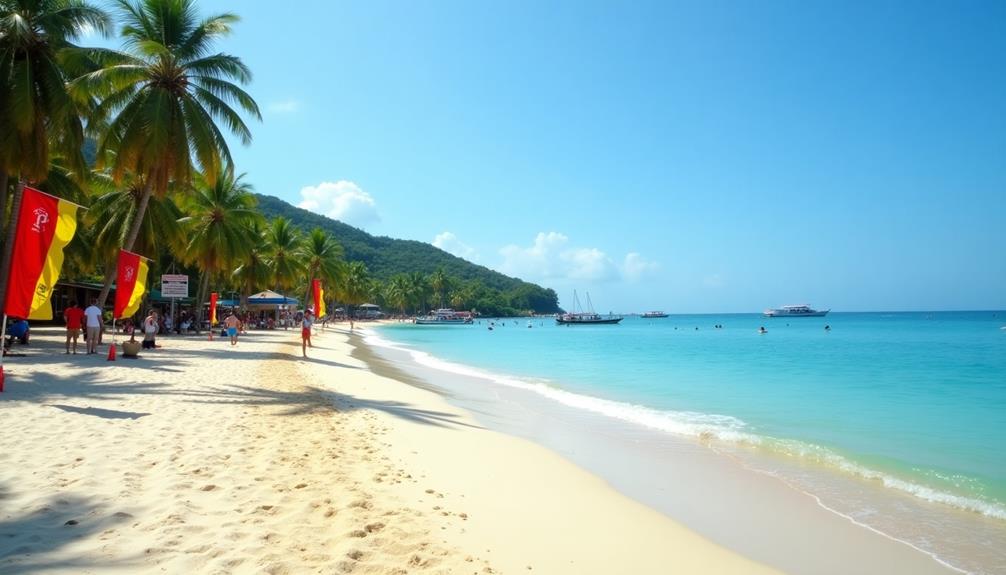
Before you plunge into Koh Samui's inviting waters, it's crucial to familiarize yourself with the local regulations to guarantee a safe and enjoyable experience. Yes, even paradise has rules, but don't worry—they're pretty straightforward and won't put a damper on your beach bliss.
First off, not all beach access points are created equal. Some beaches are public, while others are private and may require you to be a guest of a hotel or resort. So, double-check before you set up your umbrella.
If you're planning an extended stay, you might want to reflect on renting a villa or apartment; one-bedroom apartments average $500/month.
As for swimming permits, relax—you won't need to carry around extra paperwork just to take a dip. However, certain activities like snorkeling or diving might require permits, especially in protected marine areas.
Lastly, keep an eye out for signage. Koh Samui's beaches often feature signs indicating safe swimming zones and areas where swimming is prohibited for your own safety.
Here's a quick rundown:
- Check beach access: Verify you're allowed to enter the beach.
- No swimming permits needed: But permits may be necessary for other activities.
- Follow signage: Respect safe swimming zones and restrictions.
- Mind lifeguard instructions: They know the waters better than anyone.
Stick to these guidelines, and you'll have a splash-tastic time in Koh Samui!

